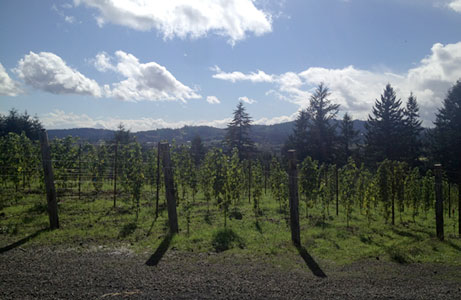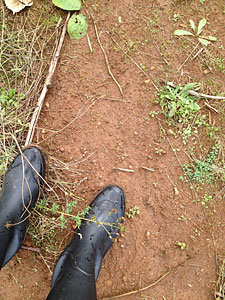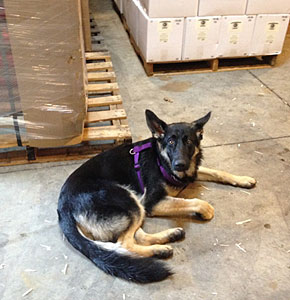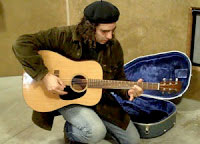| « Previous | News | Next » |
June 11, 2014
Oregon Soil...It's what's for dinner.
Jay Somers is a man of many passions—his dogs, his guitar, and—where this matters to his devotees, who are legion—his soils. As proprietor of J. Christopher Winery, he hand crafts wines that are so deeply zeroed in on place that he eschews the term “Oregon wines” as too broad. What he makes are Willamette Valley wines, and good ones: Pinot Noir and Sauvignon Blanc that show a Burgundy and Sancerre influence while showcasing the nuances of the AVAs in Willamette Valley.
His winery is located in the northern part of the valley in the Chehalem Mountains AVA, a large appellation near Portland, where Jay lives. Here, there are ancient seabeds, red soils from lava flows down the Columbia River, and windblown glacial sediment, with elevations ranging from 200 to 1600 feet. His Pinot grapes from this AVA come from 11 different soil types, and the wines tend to be more fruit-driven. To preserve the subtlety imparted by each soil type, he ferments the grapes from each parcel separately, and then blends the juice. Jay regards blending as a pivotal part of the process, and it’s where you can most directly see his touch. He solicits opinions from his team, and most importantly, his wife, Ronda, but this is where the craft of winemaking becomes his art.
Appassionata Vineyard - J. Christopher Estate Vineyard

 The beauty of Jay’s focus on individual AVAs is that they get expressed so distinctly in the different wines. The red—really red—Dundee Hills are much more homogenous than Chehalem Mountains, and the wines reflect the deep, iron-rich, volcanic soil with a pronounced “sanguine” quality. It’s Pinot in a softer style. “It’s refined. Seamless,” says Jay. The soils in the Eola-Amity Hills, on the other hand, impart texture and minerality. At peak elevation, the soils are very rocky and volcanic. He’s only been working with vineyards in this AVA since 2010, but they are some of his favorites. He loves the area. It has an eastern slope, not far from the Brooks Estate property.
The beauty of Jay’s focus on individual AVAs is that they get expressed so distinctly in the different wines. The red—really red—Dundee Hills are much more homogenous than Chehalem Mountains, and the wines reflect the deep, iron-rich, volcanic soil with a pronounced “sanguine” quality. It’s Pinot in a softer style. “It’s refined. Seamless,” says Jay. The soils in the Eola-Amity Hills, on the other hand, impart texture and minerality. At peak elevation, the soils are very rocky and volcanic. He’s only been working with vineyards in this AVA since 2010, but they are some of his favorites. He loves the area. It has an eastern slope, not far from the Brooks Estate property.
The 2011 vintage was a “perfect storm” of weather and cool temps for the elegant, focused style of wine he’s making. Jay is an ardent practitioner of dry farming, and a member of the Deep Roots Coalition, a collective of Oregon winegrowers who farm organically and without irrigation. As such, rain at harvest can actually be welcome. “Often rain is demonized as this horrible thing,” says Jay, “but it really can be a great thing right at harvest. We tend to be in a dehydration state naturally, so the rain brings balance.” For a cool vintage like 2011, this is less crucial. The wines were naturally aromatic, low in alcohol, and beautifully textured. But for a hot vintage like this last one, it can be a godsend. As they were going into harvest for 2013, they had really high sugar and unripe fruit. But a rainstorm came through and their fruit ended up being wonderful.
Besides being primo for growing grapes, all of these volcanic soils have had an unexpected side effect—putting Jay on the Sasquatch map. When they were cultivating their estate vineyard, huge volcanic rocks were unearthed, creating a large pile of boulders. One evening, Jay was walking their older dog Bella by the boulders, and noticed that the pile had been dismantled—from the inside out. It was concave. And large rocks had been tossed 20 to 40 feet (rocks pictured below). Apparently, this is common Sasquatch practice as they hunt for squirrels—it certainly wasn’t the vineyard dogs wreaking this kind of havoc. Word spread and when someone came out to take pictures of his dogs Nina and Aja, she recognized the winery for the Sasquatch rumors she’d heard, “Oh! This is the place!” She happened to be a member of the Bigfoot Research Organization. One thing led to another, and the winery was featured on an Animal Planet show called “Finding Bigfoot.” (Episode 1, 2, 3, 4, I Declare a Squatch War) This squared well with Jay’s lifelong fascination with Sasquatch, which started with a few weird experiences working in the woods as a kid.

Sasquatch never came back, but the dogs are definitely a fixture. Bella has since passed on, but Nina and Aja are always by his side. They are both German Shepherds, and they earn their keep on vineyard rodent patrol. Nina is the humanist, with a huge vocabulary and an obsession for playing with visitors. “If you come to the winery, you WILL play ball. She won’t give you a choice.” Aja is a puppy and follows Jay everywhere.
 Before Jay was a winemaker, he was a brewer. The skills he picked up in brewing beer translate really well to making clean, focused whites. He uses a brewer’s fastidiousness in the cellar, which he’s learned is not always protocol for wineries. “When I made the switch over to wine, I was shocked at how dirty and unsterile the conditions could be. Cleanliness makes a huge difference in the wines, especially for whites,” says Jay. He also borrows from the techniques of the old world: natural fermentation, and cold, underground cellars. Clearly his attention to detail is a factor in his fresh, pure, and mineral-driven Sauvignon Blancs. He’s the largest Sauvignon Blanc producer in the valley, and the only one—to his knowledge—using acacia barrels for fermentation. Acacia is very gentle, less aggressive than oak. It’s more mineral driven, with a distinctive rice flower smell. You can use new acacia barrels and it doesn’t destroy the aromatics in the wine. You can age the wines on their lees longer without worrying about the wood becoming overbearing.
Before Jay was a winemaker, he was a brewer. The skills he picked up in brewing beer translate really well to making clean, focused whites. He uses a brewer’s fastidiousness in the cellar, which he’s learned is not always protocol for wineries. “When I made the switch over to wine, I was shocked at how dirty and unsterile the conditions could be. Cleanliness makes a huge difference in the wines, especially for whites,” says Jay. He also borrows from the techniques of the old world: natural fermentation, and cold, underground cellars. Clearly his attention to detail is a factor in his fresh, pure, and mineral-driven Sauvignon Blancs. He’s the largest Sauvignon Blanc producer in the valley, and the only one—to his knowledge—using acacia barrels for fermentation. Acacia is very gentle, less aggressive than oak. It’s more mineral driven, with a distinctive rice flower smell. You can use new acacia barrels and it doesn’t destroy the aromatics in the wine. You can age the wines on their lees longer without worrying about the wood becoming overbearing.
Jay Somers thinks Sauvignon Blanc is the best white grape for Willamette, which is close to the climate of Sancerre. Sancerre, in fact, has a huge influence on his winemaking. When not drinking Burgundy (“the Platonic ideal of Pinot”), he’s drinking Sancerre, both red and white. He also drinks Pinots from other regions of the world, plus some of his friends’ wines. And Barbaresco, Barolo. One thing you’ll never see him drink after hours is his own wine. That’s work, and when he opens a bottle he starts analyzing it. “I’m my own worst critic. All I start thinking about is the winery and the wines. Drinking should be relaxing and enjoying,” says Jay. But even drinking for pleasure turns into work. He pays close attention to how any wine he’s drinking is structured, and where acidity sits against tannin and fruit. He relates it back to music: “If you’re a jazz musician and you are studying, you transcribe all the Miles Davis tunes. It teaches you how to approach to the vineyard.”
 A longtime musician, the creative process runs deep for Jay. He’s never made a living doing it, but he’s been playing the guitar since he was 18. Sometimes his wines, and sometimes his dogs, are named after music legends—Django Reinhardt’s Nuages, Steely Dan’s Aja, Nina Simone. He’s always working on a music project here or there. One of his recent projects was with two other winemakers in a band called Vin Halen. His current band called Portland Cement is a recording project with an old college friend Roy Hinshaw and the amazing keyboard player they recruited Charlie Dennard. He just got back from a recording session in Atlanta, where they worked on their second album. He calls it “groove/soul jazzy,” and it should be finished this fall, right around harvest.
A longtime musician, the creative process runs deep for Jay. He’s never made a living doing it, but he’s been playing the guitar since he was 18. Sometimes his wines, and sometimes his dogs, are named after music legends—Django Reinhardt’s Nuages, Steely Dan’s Aja, Nina Simone. He’s always working on a music project here or there. One of his recent projects was with two other winemakers in a band called Vin Halen. His current band called Portland Cement is a recording project with an old college friend Roy Hinshaw and the amazing keyboard player they recruited Charlie Dennard. He just got back from a recording session in Atlanta, where they worked on their second album. He calls it “groove/soul jazzy,” and it should be finished this fall, right around harvest.
In addition to a new album, he’s got a new estate vineyard coming online this year. There are 23 acres in the ground right now, and nearly every acre has a different soil type. The vines are quite young, but the lots are very good. Winemaking keeps Jay interested because it’s always reinventing itself, every year, as the grapes regrow and the process begins again: “There’s always a new vintage, something new to look forward to and figure out. It’s a humbling experience.” But it’s also partly Jay’s thirst for learning and making that keeps his approach fresh. “I get better at this every year I do it. I’m always playing with new ideas, trying to make better wine. I’ve made wine 23 times. I’m 48 so when I’m 70, my wine will be amazing.” He’s skeptical of the various wines du jour that get released—made with no sense of place; just juice blended together with some monkeys on the label and some crazy marketing. You know, basically the antithesis to what he has set out to do. “I’m just trying to make these really honest wines,” Somers says, when asked about his hopes for the winery’s future. And there’s no doubt that his wines will continue to be focused expressions of Willamette—a Sasquatch-loving, music-minded, bohemian corner of the winemaking world with killer terroir and some talented, passionate personalities behind it.
